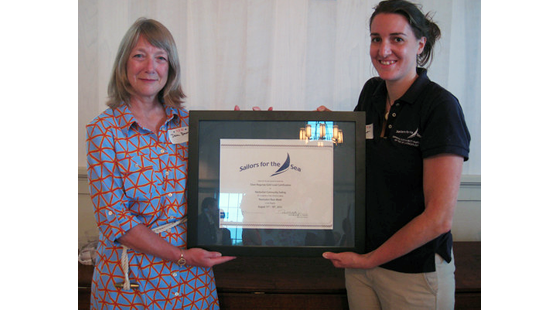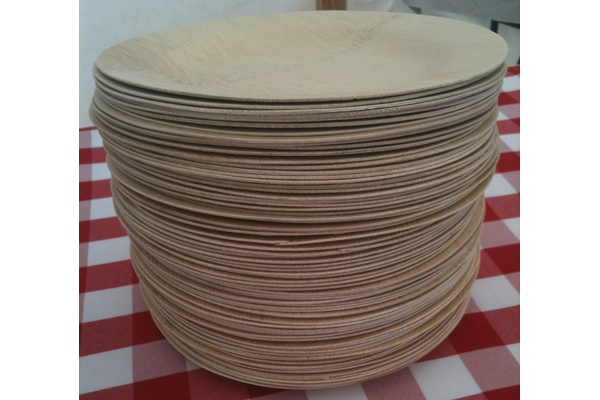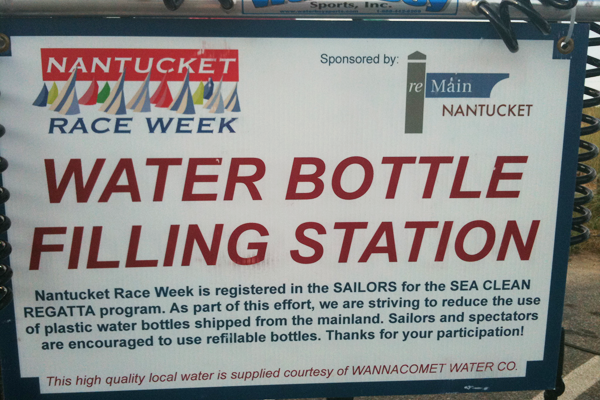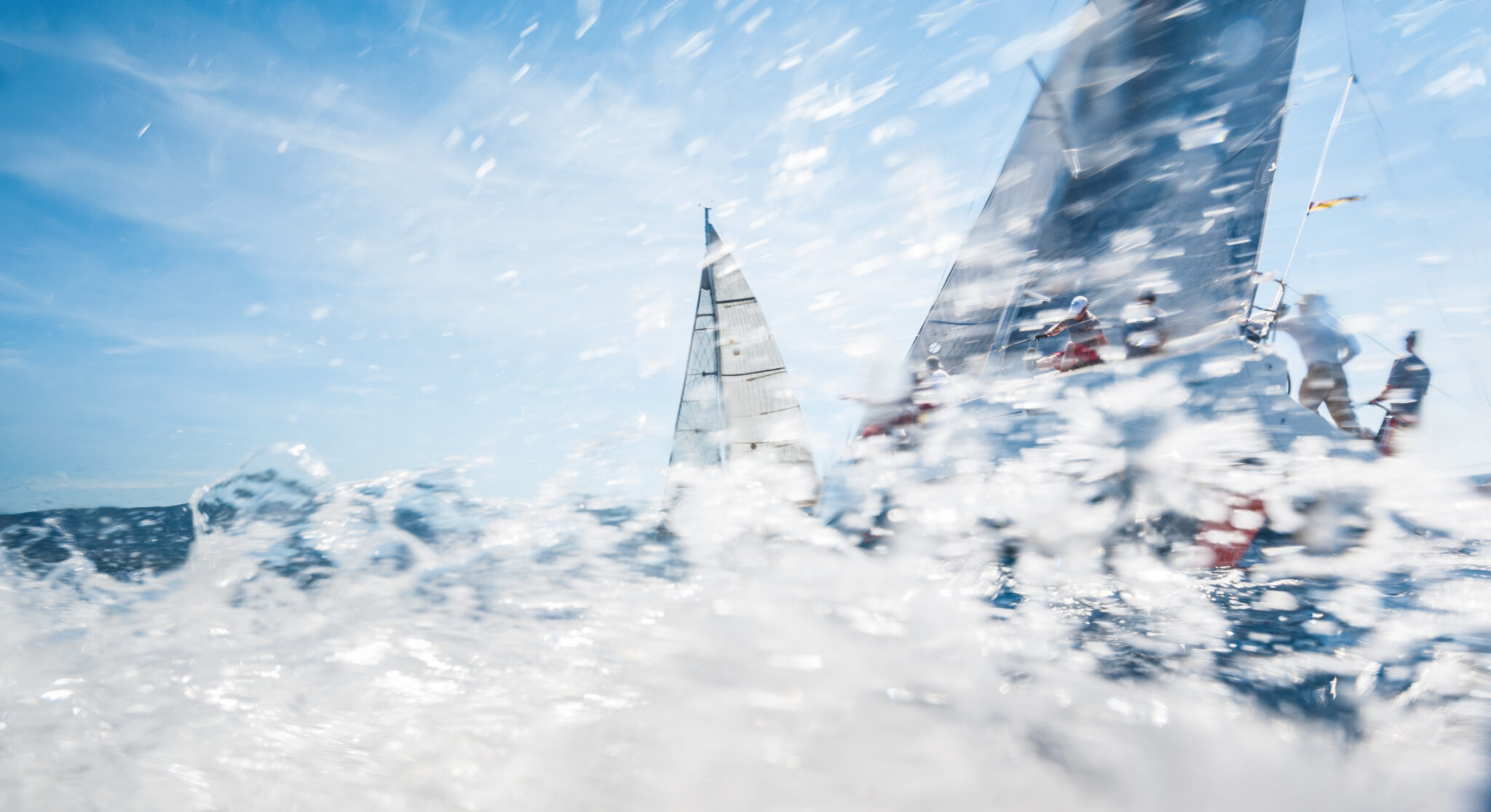



Nantucket Race Week is a 10 day event with over 3,000 participating sailors in a range of different boat classes. NRW has been participating in Clean Regattas since 2009. In 2010, the regatta went Gold with several events throughout the week. Read on for a description of how Nantucket Race Week reduced their impact of a major race event and how you can follow their lead in your home waters.
Commitment and Communication
Nantucket Race Week included the Clean Regatta Pledge and Logos on all NORs and SIs for every regatta throughout the week. This was also printed on the website, in the event program, in all press releases, mailings, articles and marketing materials. This commitment not just to the program, but to communicating the program to as wide an audience as possible truly distinguishes Nantucket Race Week as one of the most progressive events we work with. It is the cumulative effect of a series of small efforts to get the word spread that helps make Clean Regattas an effective program.
In 2011, ReMain Nantucket is providing every boater who visits their shores with a Clean Boating Resource created with the help of Sailors for the Sea’s Clean Regattas Resources. This type of advance work can make a huge difference when it comes to the day of your event.
Green Team and Liaison
Nantucket Race Week assigned a volunteer to communicate directly with Sailors for the Sea for all support and assistance. The regatta established an 8-person Clean Regatta Committee for the event that also made up the core of the Green Team, responsible for communicating to individual skippers and fleets, and organizing post-regatta clean ups around the island. The Committee was made up of representatives from the regatta organization and ReMain Nantucket. The cleanup was formally organized with the Nantucket Clean Team and focused on the high-impact areas around Jetties Beach and the Opera House Party. The Green Team grew from 25 volunteers in 2009, to 40 in 2010.
The Green Team also conducted interviews on local Plum TV, demonstrated the use of dye tablets and efficient engines, and hosted education displays of island-wide conservation efforts and organizations, including Sailors for the Sea. Combining direct communication to fleets, promotion at other events, educational displays and media coverage, Nantucket Race Week had 88 distinct messaging opportunities, which the took to promote Clean Regattas.
Reduce, Reuse, Recycling
- Asked each event/function to adhere to best efforts of recycling as well as Eco-friendly products.
- Purchased biodegradable supplies from Greenware for the Opera House Cup Party. Cups were NatureWorks® made from biopolymer (and corn); plates are GreenWave (sugarcane, grass and reed plasma).
- Distributed water bottles in 100% recycled bags. Bags donated by ReMain Nantucket.
- Distributed daily lunches in reusable bags. Bags donated by J. McLaughlin.
- Provided recyclable pickup for returning regatta boats in anchorage. Service provided by GoFer, Channel 77.
- Provided 3 recycling containers meeting requirements of Nantucket at all locations where boats return/depart (Boat Basin, NYC, Town Docks, GHYC, Polpis, Jetties Beach NCS location).
- Provided 5 gallon reusable water containers for refilling of water bottles while racing to cut down on use of plastic bottles.
Trash Free Regatta
With the efforts described in the Green Team and Recycling sections above, Nantucket Race Week was able to keep their shores and seas clear of debris, and alleviate an otherwise major impact that thousands of visitors can have on a fragile shoreline.
Water Bottle Initiative
One of the biggest efforts undertaken at Nantucket Race Week was to try and achieve the goal of reducing the event’s reliance on disposable plastic waters bottles by 90% in 2009, and an additional 50% in 2010. To accomplish this, Nantucket Race Week:
- Provided stainless steel water bottles to each participant (skipper and crew) to decrease amount of plastic water bottles used. The reusable bottles were provided by an anonymous donor.
- Provided temporary water refill facilities at departure locations that were not equipped for increased water usage (NYC, Boat Basin). The stations were purchased from Waterboy and connected to a meter to measure total use of water throughout the event.
- Used local water, supplied by Wannacomet Water Company, to eliminate transportation of off island water.
- Provided bulk water at OHC Party (1100 attendees).
In this way, Nantucket Race Week used 2,160 fewer disposable bottles in 2009 than in 2008. By 2010, the organization was only purchasing about 120 single-use bottles for the entire week-long event, providing water through municipal and bulk sources instead. Read more about how you can reduce your reliance on water bottles in our Clean Regatta resources.
No Discharge
Though Nantucket Harbor is a No Discharge Zone, Nantucket Race Week took the next step by providing dye tablets for all holding tanks. This tell-tale colored dye alerts organizers to anyone violation the No Discharge Zone, and encouraged all visitors to use local pumpout boats when necessary to empty their tanks.
Non-Toxic Cleaning Products
Nantucket Race Week provided a list of where “green” products can be purchased on the island. In 2011, their new Prep List for Boat Owners goes into greater detail on non-toxic products, how to make organic versions of boater cleaners in your kitchen, and recommends a few branded items for purchase. Sailors for the Sea also offers a Clean Boating Guide with information on non-toxics that can be distributed among skippers.
Oil Spill Prevention
Nantucket’s Marine Trades Association donated bilge sponges and fuel pads that were used on every motorized sailing vessel, and each committee, mark and support boat.
Phosphate and Nitrate Reduction
For years, scientists at UMass Boston Nantucket Field station have measured the levels of phosphates and nitrates in Nantucket Harbor, noting significant spikes with the increased boating activity during the summers. In 2009 and 2010, however these spikes were lower during Nantucket Race Week, partially due to the new emphasis on water only wash-downs by boats visiting in the harbor. We look forward to posting more thorough data, and seeing this trend continue in subsequent years. Get more information on the effects of phosphates and nitrates on your waters and how you can alleviate the effect.
Bottom Paint
Starting in 2009, Nantucket Race Week’s support, committee and mark boats for the 420, Opti and Laser fleets were all painted with non-toxic ePaint. Supporters of Sailors for the Sea can receive 25% off of ePaint products.
Regatta Awards
In lieu of traditional awards, winners in the 420, Opti and Laser fleets were given tote bags as awards, donated by Haul Over and made of 100% recycled materials.
Engine Efficiency
All but one Nantucket Community Sailing motor boats were converted to the more efficient 4-stroke engine for use during the race and after.


